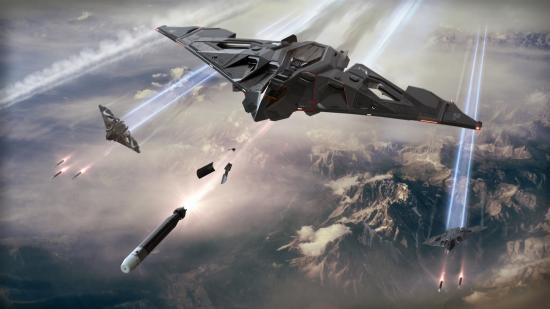Update, January 8: CIG and RSI’s lawyers are trying to get Crytek’s lawsuit dismissed, saying Crytek “sacrifices legal sufficiency for loud publicity.”
Ahead of Christmas last year, Crytek filed a lawsuit against Cloud Imperium Games (CIG) and Roberts Space Industries (RSI), the developers of Star Citizen, claiming that the companies had infringed the copyright of Crytek’s CryEngine (the software underpinning Star Citizen) and breached the contract that the engine was licensed to them under. On January 2nd, that initial complaint was amended to change the language of some of Crytek’s claims. CIG and RSI’s lawyers have now responded to both complaints, filing a motion to dismiss the suit, stating that Crytek “sacrifices legal sufficiency for loud publicity.”
The motion opens by saying that many of Crytek’s claims don’t hold water when you read through the game license agreement (GLA) CIG signed with Crytek back in November 2012, just after the Kickstarter campaign wrapped up. “The GLA eliminates virtually every claim and remedy Crytek seeks,” CIG and RSI’s lawyers write. “Crytek’s admission that Defendants are not even using Crytek’s software gets rid of the rest.” Appended to the motion to dismiss is a copy of the GLA, a document Crytek had left out of its filing in its original and amended complaints.
CIG and RSI’s lawyers claim the document was “deliberately omitted” because the document’s “express language precludes Crytek’s claims and remedies as a matter of law.” In Crytek’s initial and amended complaint, the company claims that the GLA only allows CIG and RSI to make one game with the CryEngine and that Squadron 42, Star Citizen’s singleplayer, counts as a separate game, in part because it can be bought as a standalone game in the RSI store. CIG and RSI’s lawyers dispute this, saying that “Crytek pleads that CIG’s alleged previous use of the Engine in ‘Squadron 42’ exceeds the scope of the GLA. The omitted GLA reveals that the defined term ‘Game’ where CIG can use the Engine includes both ‘the game currently entitled ‘Space Citizen’ and its related space fighter game ‘Squadron 42.’”
Here’s the relevant definition from the GLA signed on November 20th, 2012:

(The lawyers don’t mention that whoever wrote up and checked the GLA failed to notice the game is called Star Citizen and not ‘Space Citizen’).
So, CIG and RSI’s lawyers are arguing that from the moment the GLA was signed, everyone involved understood that Squadron 42 fell under the umbrella of Star Citizen, and it wasn’t a separate game that breached the terms of the GLA.
The lawyers go on to argue, too, that because the developers announced their move to Amazon’s Lumberyard engine in December 2016, it is no longer CryEngine in Squadron 42 “thus rendering Crytek’s related claims for breach of the GLA and copyright infringement subject to immediate dismissal.”
“Crytek attempts to hide this dispositive fact from the Court by misrepresenting the contents of the 2016 Press Release,” CIG and RSI’s lawyers write. “To support its meritless claim that CIG broke a non-existent obligation to use the Engine in the Game, Crytek alleges, […]: ‘On December 23, 2016, Defendants announced that they were using the Amazon Lumberyard video game engine for StarCitizen.’” The lawyers call this “a blatant misrepresentation of CIG’s announcement” because, they claim, it suggests only Star Citizen had moved to Lumberyard, when in fact the press release states that “[CIG] had switched to Amazon Lumberyard for both Star Citizen and Squadron 42.” And, so, the lawyers claim, “Crytek’s claim that CIG is breaching the GLA by using the Engine in Squadron 42 is flatly contradicted by the 2016 Press Release, which makes crystal clear that CIG is using Lumberyard, not the Engine, in Squadron 42.”
It gets complicated here, with Crytek claiming there has been a breach of contract while Squadron 42 and Star Citizen was being developed within CryEngine, and so under the terms of the GLA. We’ve contacted CIGs lawyers why a move to a different engine would absolve CIG and RSI of a prior breach.
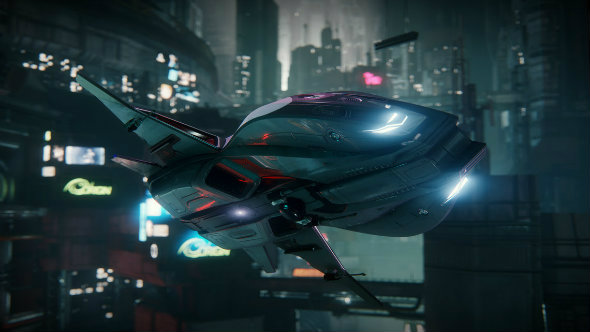
In the initial and amended complaint, Crytek claim that when CIG and RSI moved development of Star Citizen to Lumberyard they breached an exclusivity clause in the GLA stating that the developers would make Star Citizen in CryEngine alone. CIG and RSI’s lawyers counter, saying that “The GLA further shows that CIG has an exclusive right, not a duty, to use the Engine in the Game. Through hiding the GLA, Crytek contorts the word ‘exclusively’ to argue that the word means that CIG somehow is required to use the Engine in the Game.”
CIG and RSI’s lawyers argue that “the word ‘exclusively’ simply means that CIG’s right to use the Engine in the Game is exclusive to CIG and Crytek may not give that right to anyone else.”
Another point in Crytek’s complaint that the motion counters is that CIG and RSI breached the GLA when they failed to include trademark notices in promotional materials, indicating that Star Citizen was built in the CryEngine. The lawyers argue that “CIG’s obligation to include copyright and trademark notices for Crytek necessarily applies only when CIG actually uses the Engine, which Crytek pleads CIG is not.”
However, as we pointed out after the initial complaint in December, there was at least one instance prior to the move to Lumberyard where Crytek’s trademark was left out of a promotional video – the Gamescom demo from 2016:
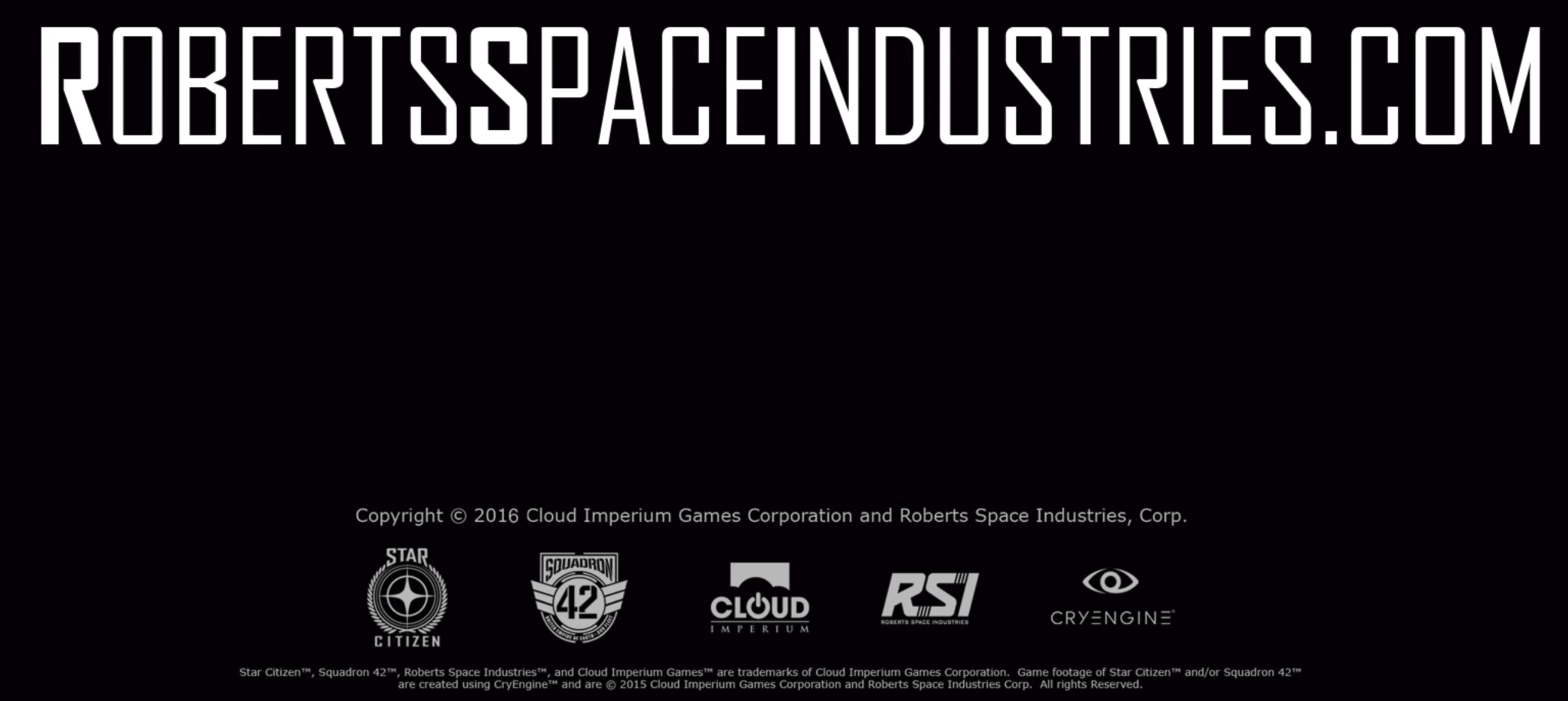
CIG and RSI’s lawyers add that including the notices “would misrepresent reality and could mislead that CIG is using Crytek’s Engine when it is not, precisely as Crytek admits.”
As a hint to some behind the scenes communication, CIG and RSI’s lawyers point out that between Crytek’s initial complaint and amended complaint Crytek’s lawyers have added “intentionally” before the words “breached the GLA”. They claim this is because they pointed out to Crytek’s lawyers that the GLA is pretty clear that neither party, Crytek or CIG, can seek damages against the other, except in instances of “intentional acts or omissions or gross negligent acts”.
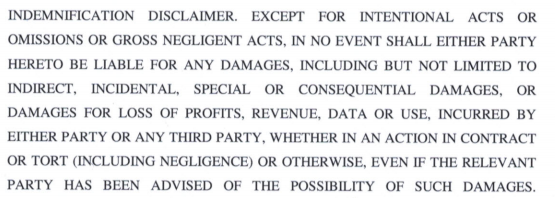
CIG and RSI’s lawyers are pretty brutal about this language change, saying “Crytek’s meager attempt to circumvent the GLA’s clear prohibition against either party seeking damages from the other should be rejected.”
It’s important to Crytek that they can prove damages because, as CIG and RSI’s lawyers point out, their breach of contract complaint won’t stand. And, that ‘intentional ‘damages in this case come under quite narrow definitions:
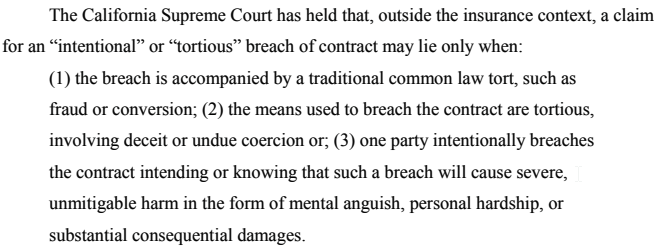
One surprising defence is that CIG and RSI’s lawyers also question why RSI is even mentioned in the complaint, as the company isn’t a signatory of the GLA:
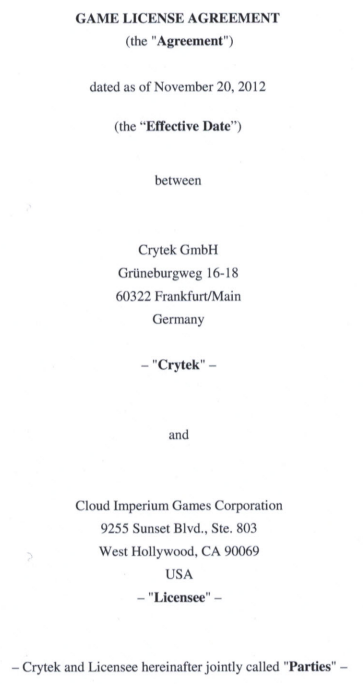
CIG and RSI’s lawyers say that “Crytek’s Initial Complaint contained no allegations whatsoever regarding RSI, nor did it explain why RSI is included as a defendant to the breach of contract or copyright infringement claims. “However, in the amended complaint, Crytek change the language to tie RSI into the complaint, saying “By their actions and conduct, Defendants established that RSI was bound by the GLA as if it were a signatory thereto. […] This “threadbare” allegation, which fails to identify any “actions” or “conduct” by RSI that would bind it to a contract between two other parties, is entirely conclusory and provides no basis for naming RSI as a defendant to either claim in this action.”
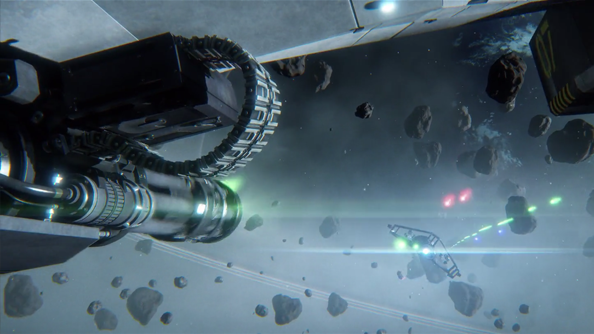
Finally, CIG and RSI’s motion to dismiss claims that Crytek’s complaints are derogatory to CIG co-founder Ortwin Freyermuth and CIG employee Carl Jones.
In the initial complaint, Crytek said “On November 20, 2012, Crytek and Defendants entered into a GLA that was extensively negotiated. The negotiations on behalf of the Defendants were led by one of the Defendants’ co-founders, Freyermuth. In prior years, Freyermuth had represented Crytek in negotiations of similar license agreements with third parties and had confidential information about Crytek’s licensing practices. The negotiations on behalf of Crytek were led by Carl Jones, then an employee of Crytek. Jones later left Crytek and became an employee of Defendants.”
CIG and RSI’s lawyers say these allegations are “‘immaterial’ because they have ‘no essential or important relationship’ to Crytek’s claim for breach of the GLA or infringement of the Engine”; and, that the allegation that Freyermuth’s involvement in the negotiations was a conflict of interest is false because “Freyermuth had obtained a written conflict waiver from Crytek prior to negotiating the GLA on behalf of CIG.” Neither party has included this waiver, unfortunately.
The lawyers go on to say that “Although Crytek amended the Initial Complaint under the shadow of an impending Rule 11 motion, in part by removing the false statement regarding Mr. Freyermuth, Crytek deliberately left in a statement insinuating that Mr. Freyermuth engaged in improper conduct by negotiating the GLA on behalf of CIG, even though Crytek knows full well that it executed a written conflict waiver and that the allegation regarding Mr. Freyermuth bears no connection whatsoever to either claim asserted against Defendants. Likewise, by stating that Mr. Jones became an employee of Defendants after negotiating the GLA on behalf of Crytek, without disclosing that Mr. Jones left Crytek years later, for reasons that had nothing to do with Defendants, Crytek casts Mr. Jones in a ‘cruelly derogatory light,’ again without the statement having any bearing on either of Crytek’s claims.”
While this motion to dismiss responds to many of Crytek’s claims, it doesn’t address things like Crytek’s claim that Chris Roberts referred to the game engine as the “Star Engine”, a use of language that “publicly sought to minimize Crytek’s contribution to Star Citizen.” Nor does the motion respond to the claim that CIG were in breach of the GLA by revealing CryEngine source code in their series of bugsmashers videos.
The next step in this trial will be to see if the judge accepts the motion to dismiss or if the complaint will go ahead.
Original story, December 13: Crytek have filed court documents to sue Cloud Imperium Games (CIG) and Roberts Space Industries (RSI), the developers behind Star Citizen, for breach of contract and copyright infringement. The company behind CryEngine say these breaches of contract and copyright infringement “have caused substantial harm to Crytek.”
However, in a statement sent to us, CIG and RSI called the lawsuit “meritless”.
“We are aware of the Crytek complaint having been filed in the US District Court,” CIG say in their statement. “CIG hasn’t used the CryEngine for quite some time since we switched to Amazon’s Lumberyard. This is a meritless lawsuit that we will defend vigorously against, including recovering from Crytek any costs incurred in this matter.”
The complaint filed on Tuesday evening begins with a history of Crytek’s relationship with CIG and RSI, how they helped with Star Citizen’s Kickstarter campaign before entering into a Game License Agreement. It’s that agreement which Crytek claim CIG and RSI have breached.
It opens in 2012, when Star Citizen’s developers were preparing for their Kickstarter campaign, Crytek helped them prepare promotional materials.
“To make that game a reality, Defendants sought to use the CryEngine video game development platform as its foundation,” the complaint states. “Crytek and Defendants agreed to preliminary license terms, and Crytek invested significant time and expense in creating impressive demonstrations and proofs-of-concept that were used to persuade the public to contribute financially to a ‘crowdfunding’ campaign to support development of the video game.”
Following the successful Kickstarter campaign, Crytek, Cloud Imperium Games, and Roberts Space Industries formalised their relationship with a Game License Agreement. In the complaint, Crytek claim that CIG and RSI promised to “use the CryEngine game development platform exclusively and to promote that platform within the video game, to collaborate with Crytek on CryEngine development, and to take a number of steps to ensure that Crytek’s intellectual property was protected.”
Crytek also claim that they charged Star Citizen’s developers “a below-market license rate” in exchange for, among other things, agreeing to “prominently display Crytek trademarks and copyright notices in the Star Citizen video game and related marketing materials.”
Another point Crytek raise in their complaint is that, negotiating against Crytek was Ortwin Freyermuth, Cloud Imperium Games’ co-founder. Freyermuth had represented Crytek in similar negotiations with third parties in the past. “Notwithstanding that he had confidential information about Crytek’s licensing practices that would unfairly advantage Defendants,” the complaint states, “Freyermuth never recused himself from those negotiations and never resolved that conflict of interest with Crytek.”
Crytek’s complaint also points out that Carl Jones, who negotiated with Star Citizen’s developers on Crytek’s behalf, later became an employee of Cloud Imperium Games.

Crytek make a number of claims against CIG and RSI in their court filing. The first is that the companies are making more than one game using CryEngine without permission.
According to Crytek, the Game License Agreement that CIG and RSI signed only permits them to make a single game with Crytek’s technology, something they claim was made clear in the negotiations.
Yet, during a livestream on December 16, 2015, CIG announced that Squadron 42, the single-player campaign of Star Citizen, was going to be sold separately. And in January 2016, CIG “made a further public announcement about Squadron 42, stating that it would be made available for purchase as a standalone video game.” Which refers to this blog post.
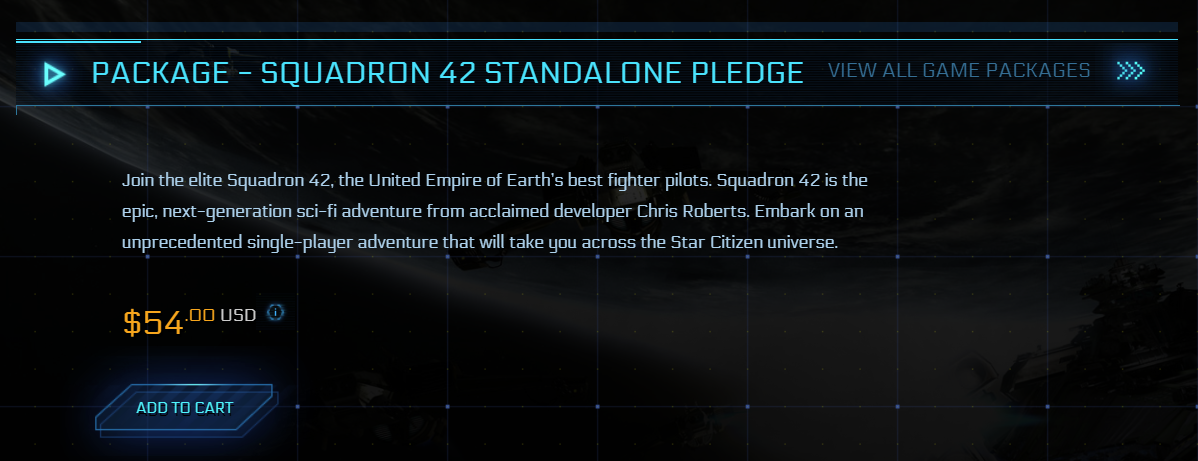
Crytek say they told CIG and RSI back in February 5, 2016 that they were not allowed to distribute Squadron 42 as a standalone game. Later that month, on February 14, CIG and RSI started selling Squadron 42. Crytek claims that this means the “Defendants are intentionally and willfully using CryEngine without a license and in violation of copyright laws.”
The document also states as evidence that CIG and RSI considered Star Citizen and Squadron 42 as two games because, on December 23, 2014, they said in a press release that “[b]oth games are currently in development and are backed by a record-breaking $139 million crowd funded effort.”
Crytek say in the complaint that they have been “substantially harmed by being deprived of that compensation, which would ordinarily include a substantial up-front payment as well as a substantial royalty on game sales.”
Crytek also claim that CIG and RSI “removed Crytek trademarks and copyright notices from their games and marketing materials without permission.”
You can see in Star Citizen’s original reveal trailer that it ends with a CryEngine splash screen:
Another detail in Crytek’s complaint is that the Game License Agreement stipulates that the splash screen, credits, documentation, and packaging, as well as the marketing materials for Star Citizen needed to include Crytek’s copyright notice and both the Crytek and CryEngine trademarks. You can see in the Gamescom 2016 demo, that CIG and RSI did not follow those directions:
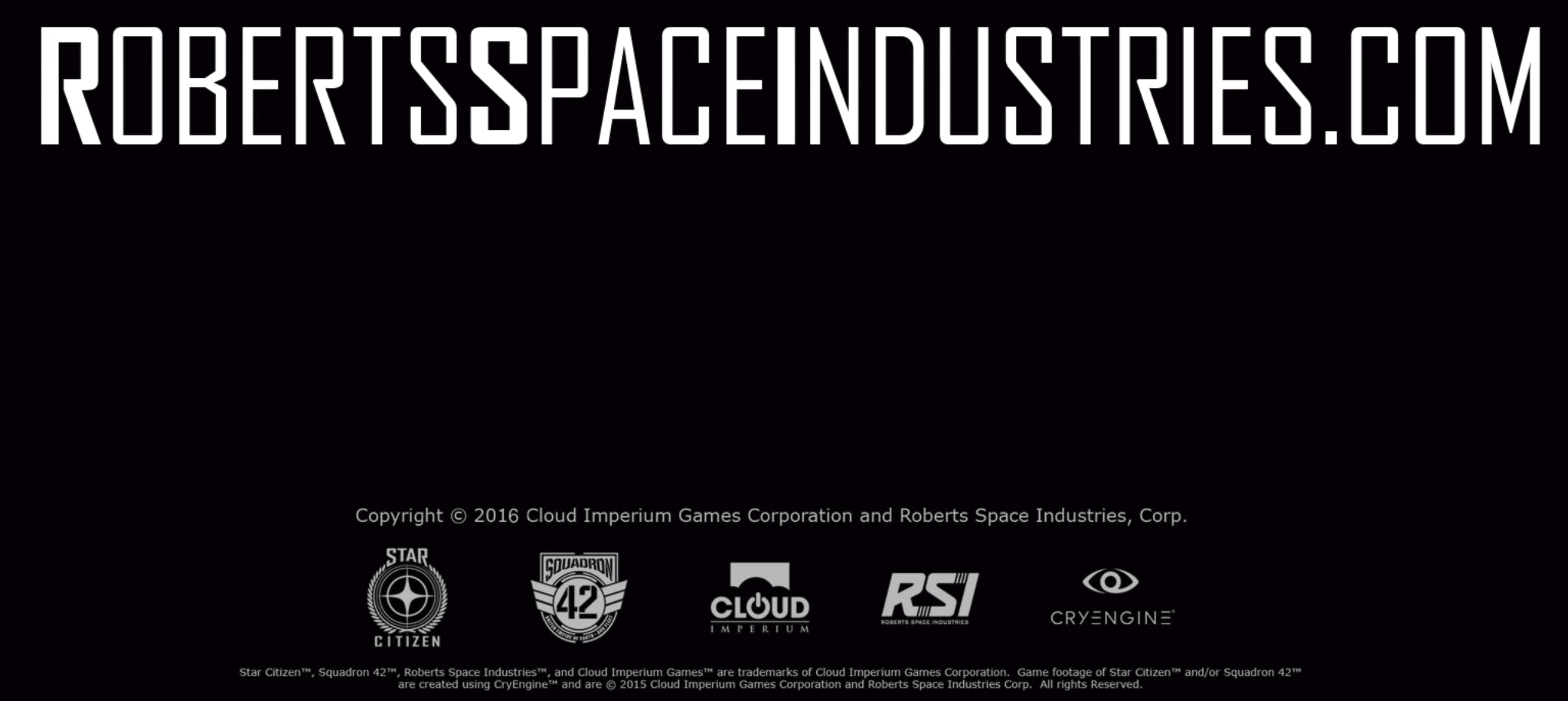
It includes the CryEngine trademark but not Crytek’s.
According to the complaint, “[CIG and RSI] knew Crytek’s right to display its trademarks and copyright notices in the Star Citizen video game and related marketing materials was a critical component of the GLA. Yet, by at least September 24, 2016, Defendants’ co-founder Chris Roberts publicly sought to minimize Crytek’s contribution to Star Citizen, stating that ‘we don’t call [the video game engine] CryEngine anymore, we call it Star Engine’”
(Skip to 18.10)
Crytek say that CIG and RSI received “a substantial reduction from Crytek’s usual licensing fees in view of the promotional consideration.” They then say that because “Crytek has been deprived of that promised consideration, Crytek has been substantially damaged, and has failed to receive the balance of its full, usual license fee.”
Another promise Crytek say CIG and RSI broke was to exclusively use the CryEngine to develop Star Citizen when it moved to Amazon’s Lumberyard and that this engine shift has damaged Crytek, as they have “failed to receive the benefit of the favorable attention that it otherwise would have derived from Defendants’ use of CryEngine in Star Citizen.”
In the complaint, Crytek state that another part of their agreement with CIG and RSI was that the developers would provide bug fixes and optimisations to CryEngine “on at least an annual basis.”
On November 16, 2015, Crytek say they asked for “long overdue bug fixes and optimizations from [CIG and RSI]” and that the developers “did not make a good faith effort to provide Crytek with the promised bug fixes and optimizations to the CryEngine as a complete compilable version.”
The next year, Crytek say that they told CIG and RSI that they were in breach of the Game License Agreement. According to the document, CIG and RSI said they were ready and willing to comply but then did not.
Then, in June of this year, Crytek say they sent another letter requesting bug fixes and optimisations and that so far CIG and RSI “have not made a good faith effort to provide Crytek with the promised bug fixes and optimizations to the CryEngine as a complete, compilable version.”
The final complaint in the document is that CIG and RSI revealed CryEngine technology to third parties without permission.
Apparently, part of the Game License Agreement states that the developers “would keep the underlying technology for CryEngine (including computer source code) confidential and not share it with anyone else without first disclosing that third party and obtaining prior written approval,” that they wouldn’t “publish or distribute the CryEngine in any way, be it in source code or object code,” or “use CryEngine in any manner which may disclose the CryEngine source code or other Crytek proprietary information to any third party not otherwise authorized herein.”
Crytek claim that CIG and RSI are in breach of these promises thanks to its ‘Bugsmashers’ series – a run of videos where CIG developers talk about how they fixed bugs in Star Citizen – because “the videos contain excerpts of information from CryEngine that were confidential.”
Crytek also say that CIG and RSI are in breach after the companies partnered with Faceware Technologies in August this year. “Upon information and belief, as a result of the partnership, Faceware received access to the underlying technology for CryEngine (including computer source code),” the document states. “Defendants did not disclose this third party developer’s involvement to Crytek, let alone obtain Crytek’s prior written approval. This was entirely in breach of the GLA.”
